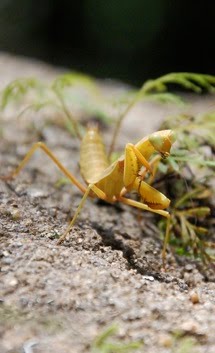No Small Feet...(Correction) Lots of Small Feet
 How do you tell the difference between a millipede and a centipede?
How do you tell the difference between a millipede and a centipede?




 How do you tell the difference between a millipede and a centipede?
How do you tell the difference between a millipede and a centipede?




 Look around all you want. You'd have a tough time finding a better set of eyes than a praying mantis. Correction, better sets of eyes. A praying mantis like this one from Andasibe, Madagascar, has more eyes than you can shake an optometrist at.
Look around all you want. You'd have a tough time finding a better set of eyes than a praying mantis. Correction, better sets of eyes. A praying mantis like this one from Andasibe, Madagascar, has more eyes than you can shake an optometrist at.
You do not look the same as a boy. Unless of course you are a boy. In that case, you do not look like a girl.
That is not always true. Yesterday we learned that those common, but still cute, brown lemurs look alike. Boy and girl brown lemurs are about the same size, weight and color.

But that is a funny thing in the animal world, because most boys and girls look different. In science-speak, that's called dimorphism (try using that in the dinner table conversation tonight).
For humans, males are usually taller. Woman usually have narrower shoulders. And think of birds. Most male birds go around bragging and boasting their colorful plumage while the females get stuck with the dull end of the feather. Those stunning red cardinals flitting around the feeders right now are all boys. The gray brownish birds looking jealous nearby are the females.

But it's not just us and the birds. Even insects get into the act. Insects have boys and girls too and most of them are different from each other. Sometimes it can be hard to tell, but not with these two lovely weevils.

There are weevils weeviling around the United States and Europe and Asia and all over the world, but none like these two. These are giraffe weevils, Trachelophorus giraffe, and they can only be found in Madagascar. In science-speak, that would make them endemic to Madagascar.
The first two pics show a male giraffe weevil and his long neck that bends like a crane. His neck can be 2-3 times longer than the neck of a female like the one in the last two pics. That long neck isn't used for fighting or for changing hard to reach lightbulbs though.
The lanky head-holder helps him build a nest by rolling up a leaf and fixing it into a tube. If the shorter necked female likes his handy work, she lays a single egg in the nest and in a few weeks a baby giraffe weevil pops out--presumably head first.
The hungry little weevil larva doesn't have to look to hard to find food. That leaf fort that Dad built is not only warm and safe; it's also tasty. In fact, it's usually a leaf from the giraffe weevil's favorite tree...the giraffe weevil tree.
Coincidence?
 Allow me to introduce the common brown lemur. And since we have talked about lemurs before let me skip the old stuff and just mention what makes these "common" primates uncommon.
Allow me to introduce the common brown lemur. And since we have talked about lemurs before let me skip the old stuff and just mention what makes these "common" primates uncommon.


 All these photos are from a wonderful little weekend away my wife and I just spent near Andasibe. We were lucky enough to lots of wonderful creatures besides these lemurs. I will put up a new post each day this week to show you everything from spiders to geckos.
All these photos are from a wonderful little weekend away my wife and I just spent near Andasibe. We were lucky enough to lots of wonderful creatures besides these lemurs. I will put up a new post each day this week to show you everything from spiders to geckos.The once tree-covered highlands around Ankafobe.
Madagascar is a weird and wonderful world of amazing plants and animals. Huge forests with towering trees and jumping lemurs. Giraffe-sized giant birds and tortoises as big as school desks roam around the hills. It is a paradise of life found nowhere else on earth.
Or at least that was true 2,500 years ago. But ever since pesky humans showed up, paradise has slowly been disappearing. Now there are very few forests or even trees for that matter. About 90% of the lush life-giving rain forests are gone. Those big birds and lumbering tortoises are extinct and so are many of the lemurs, fish, reptiles and other unique beasties that used to call the Red Island home.
There are still little bits of this once wild wonderland, but many of those bits are in trouble too. People cut down trees for houses and cooking fires they need to survive. And some people come and cut down the oldest and most beautiful trees like Rosewood to sell for lots of money. And if a tree survives the axes and chainsaws, it may not be safe yet. Fires rage around the country in many places.
Farmers burn trees and brush to make new fields for rice, beans and manioc. But fire can quite quickly get out of control and burn much more that just one or two soon-to-be fields. And without trees, the hard rains that pour down on the island for half the year can quickly wash away the good soil that used to be protected by the trees' sheltering canopy and thick roots.
This all means that it is very important to protect what forests still survive. Missouri Botanical Garden (MBG) is one of the groups trying to protect those survivors. And my wife, Dr. Cindy, is one of the scientists helping them.
These photos are from one tiny but special patch of forest that MBG is saving. It is only a fragment of what the forest used to be. But they are working hard to save what trees are left and plant new trees to make the forest bigger.
Does saving one little patch of trees make a difference? Well, just ask a Schizolaena bush.
"Hey, where in the world am I supposed to find a talking Schizolaena bush to ask?"
Well, to be honest, nowhere. Bushes don't talk. But if you want to find a non-talking Schizolaena bush, you will have to come to Madagascar. But not just anywhere in Madagascar. You have to come to a forest. And not just any forest. You will have to come to Ankafobe, this forest fragment that MBG is fighting to save. Every Schizolaena bush in the world lives in this one tiny forest. Only 100 bushes in a forest no bigger than 50 soccer fields.
That is what is called endangered. But then again, that's better than being called extinct.





